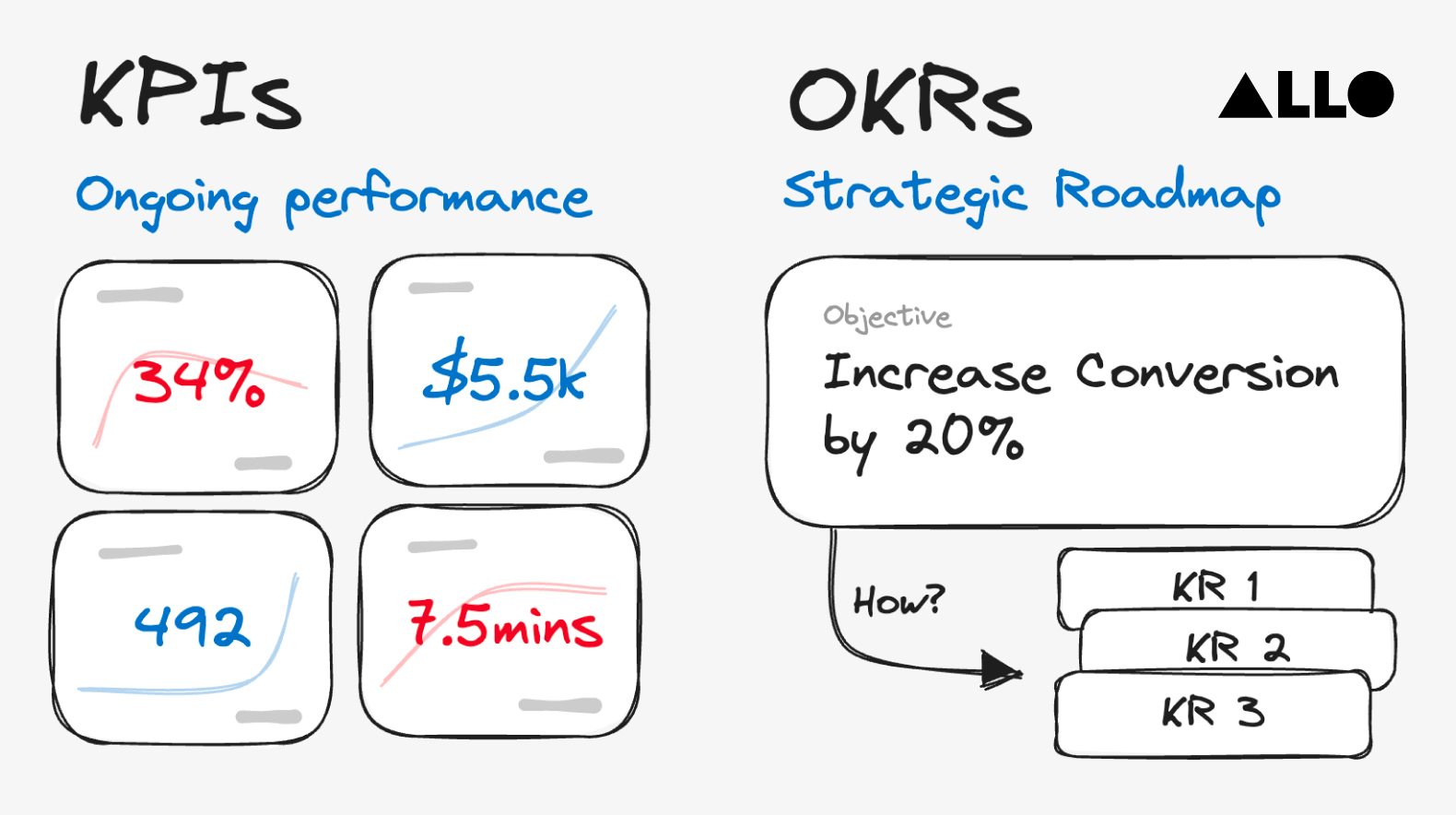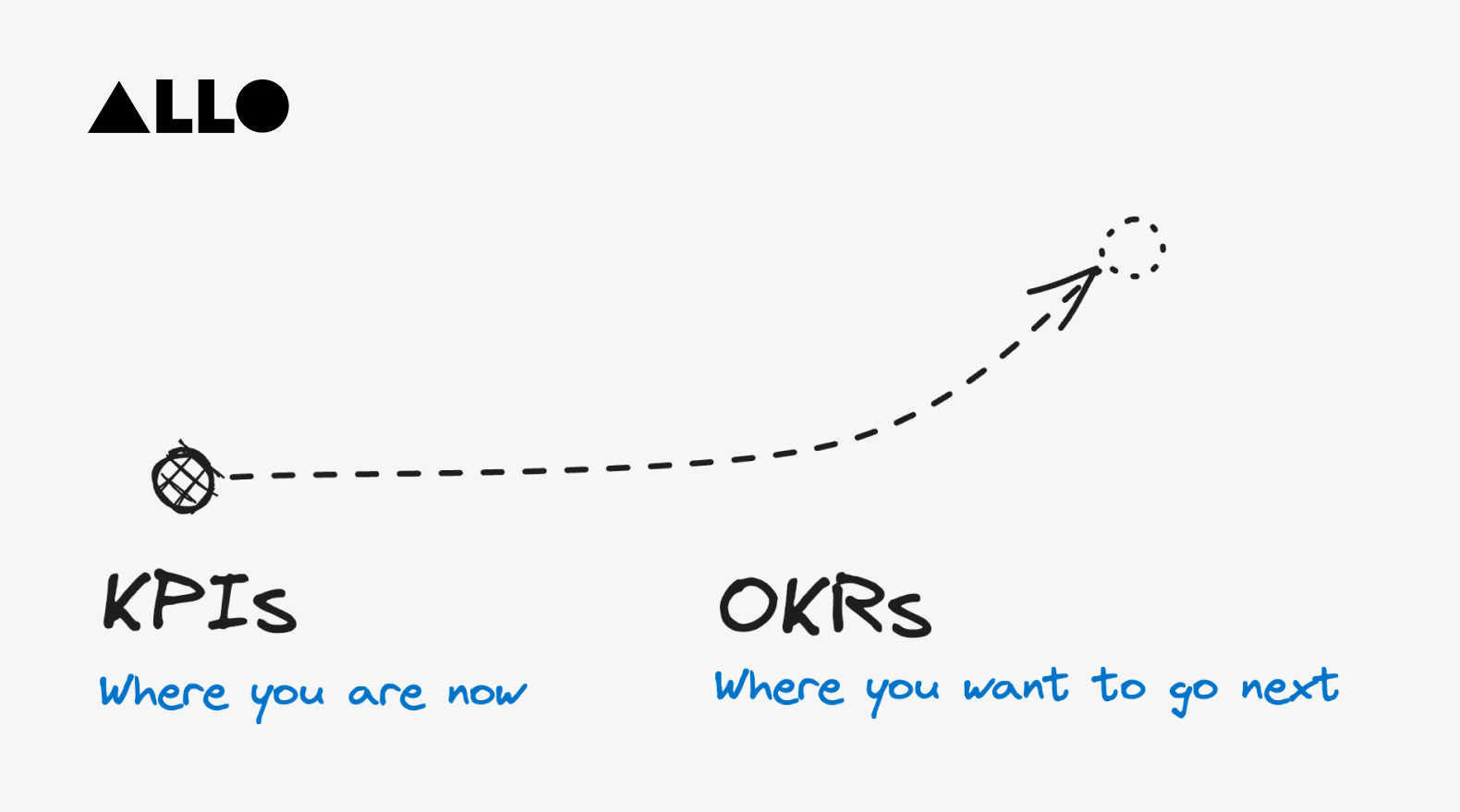Your KPIs are NOT OKRs: Here's Why (With Examples)

Many organizations use Key Performance Indicators (KPIs) and Objectives and Key Results (OKRs) to track performance and guide strategy. While they share some similarities, KPIs and OKRs serve different purposes. Simply turning your existing KPIs into OKRs is a common mistake that diminishes the power of both frameworks.
In this article, we’ll explain the key differences between KPIs and OKRs using real-world examples. You’ll learn:
- The distinct roles KPIs and OKRs play
- Why KPIs don't automatically make good OKRs
- How to transform the right KPIs into meaningful OKRs
- Examples of effective KPIs and OKRs
Let's dive in!
KPIs Track Health, OKRs Drive Change
KPIs are metrics that measure the ongoing health and performance of key business processes and outputs. They act like a "dashboard", keeping you informed if things are on-track.
For example, a SaaS company may track churn rate, recurring revenue, and cost per acquisition as KPIs. These indicate the overall "health" of the business.
OKRs, on the other hand, create a "roadmap" to drive strategic change. The Objective states the desired outcome, while Key Results define measurable milestones for achieving it.
For our SaaS company, an Objective might be "Increase self-serve conversions by 20%". The Key Results would outline specific targets to accomplish this, like "Decrease trial sign-up form fields from 6 to 3" and "Implement in-app nudges during the trial."
While KPIs track ongoing performance, OKRs aim to improve it.

KPIs Describe The Present, OKRs Define The Future
KPIs report on current or historical performance. They serve as warning signs when something goes wrong.
For example, if website traffic drops 20%, that KPI indicates a problem. But it doesn't suggest how to fix it.
OKRs chart a course to a desired future state. They outline the priorities and initiatives you'll pursue to get there.
So if the company sets an Objective to "Increase website traffic by 30%", the Key Results would detail the strategies to achieve that. Like "Implement SEO recommendations" and "Refresh blog content monthly".
KPIs describe where you are now. OKRs decide where you want to go next.

Turning KPIs into OKRs Can Backfire
Since KPIs are measurable metrics, it's tempting to turn them directly into OKR Key Results. But this often diminishes their effectiveness.
Let's say our SaaS company sets an Objective to "Reduce churn." The Key Result is simply "Decrease churn rate from 10% to 8%."
This OKR doesn't add much value. It just repurposes an existing KPI, without explaining how to influence it. There's no context around why churn is happening or what actions will reduce it.
Effective OKR Key Results outline the initiatives you'll implement to achieve the Objective. Like "Improve onboarding experience" and "Proactively contact at-risk customers."
The original churn rate KPI is still important to monitor. But the OKR inspires action by connecting the metric to strategy.
Examples of Effective KPIs vs. OKRs
Let's look at some real-world examples to see the differences between KPIs and OKRs:
KPIs
- 25,000 monthly website visitors
- $2 million revenue in Q3
- Customer satisfaction score of 4.8/5
These KPIs quantify performance in key areas like traffic, sales, and satisfaction. They act as a dashboard, tracking the health of marketing, revenue, and customer experience.
OKRs
Objective: Increase self-serve sales by 15%.
Key Results:
- Shorten free trial sign-up form from 6 fields to 3 fields
- Offer limited-time discount to customers who reference us on social media
- Create 2 new educational blog posts explaining product benefits
This OKR outlines a clear goal to boost sales, along with measurable actions to achieve it. The Objective states the desired outcome, while Key Results define how to get there through marketing and product changes.
OKRs are widespread but often implemented wrong.
— Ant Murphy (@ant_murphy) August 23, 2023
Here's 5 first principles when implementing OKRs:
👇 pic.twitter.com/ARhrgDmFO0
Align Your KPIs and OKRs for Success
Both KPIs and OKRs are indispensable frameworks for different reasons. KPIs monitor performance, while OKRs drive strategic change.
The key is aligning them together. First establish key KPIs to benchmark your business. Then set OKRs that move the needle on those KPIs in the right direction.
With clarity on their distinct roles, you can leverage both KPIs and OKRs to reach your goals. Just don't assume your existing metrics automatically make effective objectives and key results. Follow the best practices outlined here, and you’ll be on the road to success.



